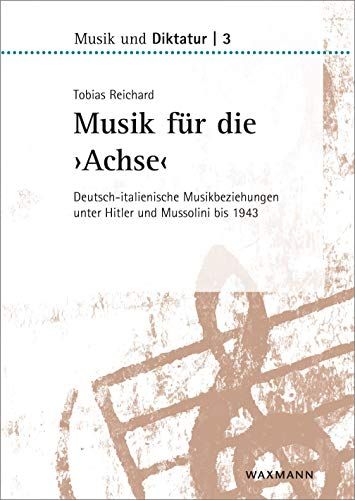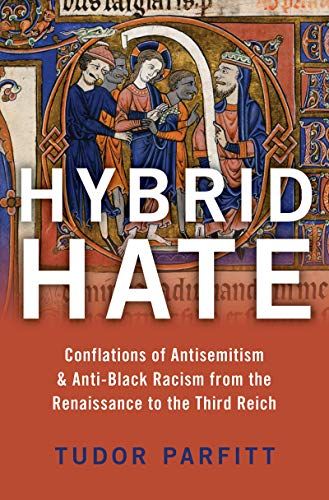
With the emergence of a bourgeois musical culture in the 19th century and the social rise of the Jewish minority in large parts of Europe from an impoverished fringe group to the center of bourgeois society, Jewish musicians began to take part in all areas of musical life. Even Richard Wagner’s anti-Jewish pamphlet and its reception in the antisemitic movement of the late 19th century did little to diminish the reputation of Jews in the musical world. However, the transfer of power to Adolf Hitler destroyed this fruitful interaction between Jewish and non-Jewish musicians in Germany. With the enactment of the racial laws in Fascist Italy, this country also entered into the dark chapter of European Jewish musical history.
Tobias Reichard, director of the Ben Haim Research Centre for Jewish Music Culture at the University of Music and Theatre in Munich, addresses this black chapter of European Jewish music history in his comprehensive, comparative study of music policy—Reichard’s central term—of National Socialist Germany and Fascist Italy in the years of the Rome-Berlin-Axis. He defines music policy as political measures to control—or prevent, as the case may be—musical performances and state influence on public debates about music.
The focus of his interest is not the role of music in political propaganda, but the state instrumentalization of middle class musical culture. From a comparative point of view, Reichard examines the similarities and differences in the political use of music in National Socialist Germany and Fascist Italy and takes a precise look at the transfer of music-political concepts.
First, Reichard examines the politicization of musical relations between the Weimar Republic and Fascist Italy. German music critics often insisted on the superiority of German music, while the influential Italian composer and music critic Alfredo Casella argued for Italian neoclassicism. Despite the spread of prejudices and clichés, German-Italian musical relations became closely intertwined. In December 1923, for example, Mussolini received the German music critic Adolf Weißmann (it should be added that Weißmann was Jewish), who wrote in a newspaper article that fascism met with approval and that Mussolini was very enthusiastic about music.
For the years 1933 and 1934, the subject of the following chapter, Reichard traces the cultural exchange between Fascist Italy and National Socialist Germany. In these years, according to Reichard, “the institutional foundations were laid for a planned […] music policy on a totalitarian scale” (p. 89). Professional corporations were founded in both countries, even if in Italy the concert agency led by the composer Livio Luzzatto, among others, was able to escape state control for a long time.
With the corporations and the formation of corresponding departments in ministries, the conditions were established for the close music-political cooperation between the two countries under the sign of the “Axis-Berlin-Rome,” the topic of the next chapter. Reichard examines in detail the German-Italian working meetings and their results as well as the censorship measures taken by the state authorities. Furthermore, he elaborates on the increasingly clear adaptation of musicians, composers, and music critics to the two regimes. Meanwhile, the German side pushed its antisemitic agitation in the field of music, staged with publicity effect in the exhibition “Entartete Musik,” which opened in May 1938, while Italian music critics initially criticized or even rejected the National Socialist cultural policy. After 1935, however, these voices fell silent. Whereas German-Italian musical relations had previously oscillated between political rapprochement and aesthetic-cultural demarcation, soon, according to Reichard, “the emphasis on commonalities and what unites them prevailed” (p. 226).
The year 1938, the subject of the following chapter, brought the darkest episode in German-Italian musical relations. From a “foreign policy community of interest,” both countries became “partners in action motivated by cultural policy and racism” (p. 227). Reichard begins by recapitulating antisemitic politics in Germany since 1933 and its consequences for musical life, before turning in detail to the development of antisemitic politics and music policy in fascist Italy. In doing so, he also points to the Jewish fascists “of the ‘first hour’,” such as the composer Renzo Massarani. Already for the first half of the 1930s, Reichard identifies an increasing spread of antisemitic prejudices, until in autumn 1937 an antisemitic press campaign raised accusations against “musical Jewry.” The music critic Alfredo Casella, who had clearly criticized antisemitic policies in Nazi Germany after 1933, and who was married to a Jewess and who had hosted an emigrated German-Jewish musician in his house, was defamed as a “stooge of an international Jewry” (p. 239). And yet, as Reichard notes, even Casella had occasionally adopted antisemitic prejudices since the mid 1930s (p. 236).
Even before the racial laws were enacted in Italy, a decree of September 1938 affected German Jews who had fled to Italy. The race laws proclaimed in November then massively restricted the lives of Italian Jewish musicians. Although “the number of persecuted people in Italian musical life,” as Reichard notes, seems rather “marginal,” he points to a number of Jewish composers, including Vittorio Rieti, Renzo Massarani or Mario Castelnuovo-Tedesco, who emigrated. Fascist Jews in musical life, on the other hand, tried to be exempted from persecution by means of an exemption for fascists of the first hour as well as for voluntary or distinguished participants in the First World War. These included the music critic Fernando Liuzzi, the composer Renzo Massarani, the violinist Riccardo Tagliacozzo, and the composer Alberto Fano, even though the latter was neither a member of the party nor had rendered outstanding services to the fascist movement. The fate of the composer Vittorio Rieti or the violinist Eugenio Supino, who were denied exoneration, also shows how contradictorily the exception was applied.
The department responsible for theatre and music in the Italian Ministry of Popular Culture (Ministero della Cultura Popolare) had already begun preparing antisemitic policies between 1935 and 1936 “on its own initiative,” as Reichard can demonstrate in a detailed and exciting reconstruction of the use by Italian authorities of a Nazi reference work on Jews in music and its various editions. The use of this Nazi manual “by the fascist authorities” is, according to Reichard, “clear evidence of their voluntary self-adaptation in the course of German-Italian rapprochement” (p. 279).
The situation of Jewish musicians became even blacker with the beginning of the Second World War, the subject of the last chapter. “Music on all Fronts” is the title of Reichard’s section on war mobilization through music, in which he now also includes light music in his investigation. Mutual guest concerts of serious music were also intended to support the “Axis” propaganda. The agitation, however, did not work through music alone; it had to be supplemented by additional language and image propaganda.
The more difficult the war situation became for the “Axis,” the more conflicts between fascist and National Socialist politicians and music promoters emerged. These became apparent—with this section Reichard concludes his study—in the production of Alban Berg’s opera Wozzek in Rome in November 1942, a work that was ostracized by National Socialists as cultural bolshevism.
The darkest chapter of German-Italian relations, the German occupation of northern Italy and the satellite regime of the Republic of Saló, including the deportations of Italian Jews that now began, is only briefly dealt by Reichard in his epilogue.
Tobias Reichard has meticulously reconstructed German-Italian cultural relations in the field of music with this accurately crafted study which is based on well-founded archival research. At the same time, Reichard has thoroughly illuminated the ambivalences of musical exchange and the ambivalent effects of music policy as well as the special role of music in German-Italian cultural relations during the Axis period in all its facets. In this context he clearly identified both the qualitative differences between National Socialist and Fascist Antisemitism as well as the Italian officials’ own contribution to the persecution of the Jews.
The appendix also contains a list of 84 Italian-Jewish musicians at the time of the enactment of the Race Laws, as well as a list of one hundred German-Jewish musicians who emigrated to Italy after 1933.
As Reichard emphasizes in the last paragraph, the German-Jewish musical relations had the most striking effect on these two groups. In the future, these should be studied more intensively, a task Reichard is now pursuing as director of the Ben Haim Research Centre for Jewish Music Culture in Munich.
